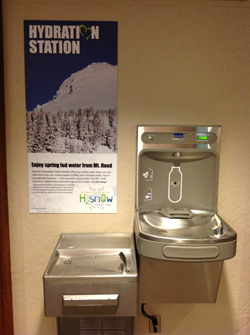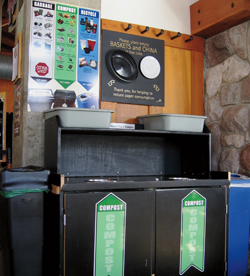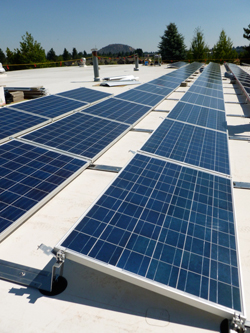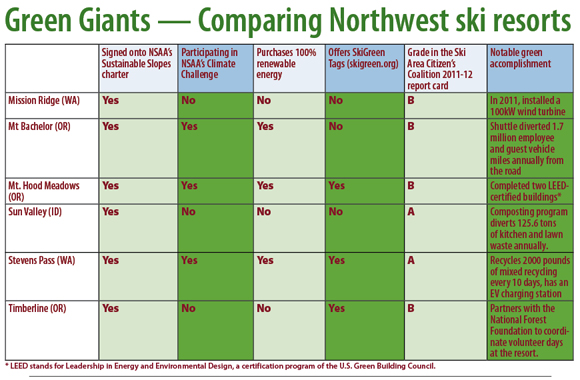NW Ski Resorts Commit to Greener Operations

Walking the talk
By Becky Brun
Photo at right: In June 2011, Stevens Pass became the first resort and only mountain pass in the country to install public EV charging stations. Photo courtesy of Stevens Pass
Throughout the U.S., resorts are using renewable energy to run ski lifts, investing more resources in shuttle busses and ditching disposable dishware—all in an attempt to curb their carbon emissions.
While success is often difficult to measure, many resorts say they are seeing a return on investment in the form of cost savings from reduced energy use, waste disposal fees and water use. So why aren’t more resorts doing it?
Dependence on Mother Nature
The move of many ski areas to make a stronger commitment to environmental stewardship is not all that surprising, given the industry’s dependence on Mother Nature.
“We see the impacts of climate change every day,” says Heidi Logosz, Sustainability Manager at Mt. Hood Meadows ski area in Oregon. “If we don’t do something, our industry will pay the price.”

Hydration stations at Mt. Hood Meadows reduce the number of disposable bottles headed to the landfill. Photo courtesy of Mt. Hood Meadows
Mt. Hood Meadows, which offsets 100 percent of its electricity use with wind power, has taken numerous steps to reduce its energy use, including completing several lighting retrofit projects involving replacing T12 linear fluorescent lighting fixtures with T8s.
The resort also installed four hydration stations to promote consumption of H²snow, pure mountain spring water from Mt. Hood, and reduce the number of disposable water bottles being sent into the waste stream.
Meadows was one of the first signees to the National Ski Area Association’s (NSAA) Sustainable Slopes charter, a voluntary program in which ski areas report progress toward environmental goals. About 70 percent of NSAA’s members, as represented by skier/snowboarder visits, signed onto the charter at the outset, according to NSAA’s Policy Director, Geraldine Link. Many cited climate change as a key concern.
In an attempt to help people connect climate change and their business operations, NSAA launched the Climate Challenge in 2012. This voluntary program is designed to recognize ski areas that are committed to developing greenhouse gas (GHG) inventories, setting goals for carbon reduction, implementing at least one on-site reduction strategy per year, and reporting success in reducing their overall carbon footprint.
Mt. Hood Meadows is one of 21 ski areas participating in NSAA’s Climate Challenge. Logosz says the resort reduced its electricity usage by 12.7 percent between 2011 and 2012, and the Challenge forced them to track this important metric of success.
Participating in the challenge is a time-consuming process, but Logosz says the Climate Challenge provides third-party verification for their efforts, which builds credibility.
About 15 miles to the west on Oregon Highway 35, Timberline Lodge and Ski Area also recognizes the importance of third-party verification of its eco-efforts. Timberline, which is also a signee to the Sustainable Slopes Charter, made a decision a few years ago to prove they are “walking the talk.” They began work with White Salmon, Wash.-based nonprofit Sustainable Travel International (STI) to undergo a rigorous certification program called STEP. In July 2011, it became the first ski area in the world to be certified to the STEP standard, achieving Silver status.
“It helped us in our efforts to make sure we are a fair-minded employer, and a good corporate citizen,” Timberline reported to STI. “And, it helped us be even more efficient by incorporating ways to reduce waste, conserve energy and cut costs.”

Composting at Stevens Pass has decreased the amount of food scraps by 90 percent at its busiest lodge. Photo courtesy of Stevens Pass
In Washington, Stevens Pass Director of Planning John Meriwether says energy savings and building street cred among Seattle’s eco-conscious consumers helped inspire the creation of its environmental program more than a decade ago.
In 2012, Stevens Pass placed second on the list of “green” ski resorts issued annually by the Ski Area Citizens’ Coalition. The coalition evaluated 84 resorts in the Western United States on environmental practices ranging from recycling to watershed protection. Stevens Pass already offsets 100 percent of its electricity use with wind power, but will soon be investing in eight 240-watt solar panels, which will be mounted to the top of various ski lifts. The panels are expected to have a four-year return on investment, thanks to state and national energy tax credits, according to Meriwether.
“The program has a lot of momentum,” Meriwether says. “We have proven that this program has saved us a lot of money, it helps with marketing, and it’s the right thing to do to fight climate change.”

The rooftop solar array on the Mt. Bachelor bus depot completely powers the Carrousel beginner lift. Photo courtesy of Mt. Bachelor
Mt. Bachelor near Bend, Ore., recently installed a solar panel array atop its Bend office and bus garage. The solar array generates enough electricity to power the Carrousel Chair beginner lift. Mt. Bachelor also hosts at least three Charity Ski Weeks each year, in which local nonprofits can sell reduced-priced lift tickets as a way to earn cash.
All four resorts offer their guests the option to purchase SkiGreen offsets. The $2 earned from each offset goes directly to support a carbon reduction project, such as installing solar panels on schools.
“Ski areas see the impacts of climate change,” says Tiffany Meyer, Marketing Director for Bonneville Environmental Foundation (BEF), which launched the SkiGreen program in 2007, in response to an industry desire to offer guests a way to make a difference.
The program was popular at the outset, Meyer says, but enthusiasm among consumers has fizzled a bit. BEF has minimal resources to help market the program, as do the resorts. As a result, the biggest purchasers of SkiGreen offsets end up being season pass holders, “who feel more connected and responsible” to the mountain, according to Logosz.
“Individuals change their behavior when they can see they are part of a bigger effort,” Meyer says. “The SkiGreen program really rallies individuals and helps them see the bigger impact they are having collectively.”
While the benefits of environmental programs have been proven, many ski areas lag behind the curve—citing cost and/or knowledge as a major deterrent, according to NSAA’s Link. (The Climate Challenge, for instance, costs a resort $5,000 to participate.) And almost all agree that it takes strong leadership to get ski areas to continue pushing the envelope.
“The people who work at ski areas and fill the roles of sustainability coordinators love the mountain environment. It’s their livelihood and lifestyle and they want to protect that livelihood and lifestyle,” Link says. “They realize we are a small part of a much bigger picture. You have to be a good example if you want to fight for change.”
Becky Brun is a freelance writer and outdoor enthusiast living in Hood River, Ore. She also serves as a sustainable business consultant and membership coordinator for the Gorge Owned Business Network. She is also a former editor of OutdoorsNW.




